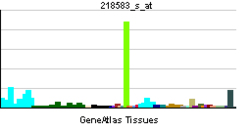DCUN1D1
| DCN1, defective in cullin neddylation 1, domain containing 1 | |||||||||||||
|---|---|---|---|---|---|---|---|---|---|---|---|---|---|
| |||||||||||||
| Identifiers | |||||||||||||
| Symbols | DCUN1D1 ; DCNL1; DCUN1L1; RP42; SCCRO; SCRO; Tes3 | ||||||||||||
| External IDs | OMIM: 605905 MGI: 2150386 HomoloGene: 10773 GeneCards: DCUN1D1 Gene | ||||||||||||
| |||||||||||||
| RNA expression pattern | |||||||||||||
 | |||||||||||||
| More reference expression data | |||||||||||||
| Orthologs | |||||||||||||
| Species | Human | Mouse | |||||||||||
| Entrez | 54165 | 114893 | |||||||||||
| Ensembl | ENSG00000043093 | ENSMUSG00000027708 | |||||||||||
| UniProt | Q96GG9 | Q9QZ73 | |||||||||||
| RefSeq (mRNA) | NM_020640 | NM_001205361 | |||||||||||
| RefSeq (protein) | NP_065691 | NP_001192290 | |||||||||||
| Location (UCSC) | Chr 3: 182.66 – 182.7 Mb | Chr 3: 35.89 – 35.94 Mb | |||||||||||
| PubMed search | |||||||||||||
DCN1-like protein 1 is a protein that in humans is encoded by the DCUN1D1 gene.[1][2][3]
DCUN1D1 is amplified in several cancer types, including squamous cell cancers, and may act as an oncogenic driver in cancer cells.[4][5][6]
Interactions
DCUN1D1 has been shown to interact with CAND1,[7] RBX1,[7] CUL1,[7] CUL3[7] and CUL2.[7]
References
- ↑ Mas C, Bourgeois F, Bulfone A, Levacher B, Mugnier C, Simonneau M (Jun 2000). "Cloning and expression analysis of a novel gene, RP42, mapping to an autism susceptibility locus on 6q16". Genomics 65 (1): 70–4. doi:10.1006/geno.2000.6126. PMID 10777668.
- ↑ Kurz T, Ozlu N, Rudolf F, O'Rourke SM, Luke B, Hofmann K, Hyman AA, Bowerman B, Peter M (Jun 2005). "The conserved protein DCN-1/Dcn1p is required for cullin neddylation in C. elegans and S. cerevisiae". Nature 435 (7046): 1257–61. doi:10.1038/nature03662. PMID 15988528.
- ↑ "Entrez Gene: DCUN1D1 DCN1, defective in cullin neddylation 1, domain containing 1 (S. cerevisiae)".
- ↑ Broderick, SR; Golas, BJ; Pham, D; Towe, CW; Talbot, SG; Kaufman, A; Bains, S; Huryn, LA; Yonekawa, Y; Carlson, D; Hambardzumyan, D; Ramanathan, Y; Singh, B (Jun 2010). "SCCRO promotes glioma formation and malignant progression in mice.". Neoplasia (New York, N.Y.) 12 (6): 476–84. PMC 2887088. PMID 20563250.
- ↑ Sarkaria, I; O-charoenrat, P; Talbot, SG; Reddy, PG; Ngai, I; Maghami, E; Patel, KN; Lee, B; Yonekawa, Y; Dudas, M; Kaufman, A; Ryan, R; Ghossein, R; Rao, PH; Stoffel, A; Ramanathan, Y; Singh, B (Oct 1, 2006). "Squamous cell carcinoma related oncogene/DCUN1D1 is highly conserved and activated by amplification in squamous cell carcinomas.". Cancer Research 66 (19): 9437–44. doi:10.1158/0008-5472.CAN-06-2074. PMID 17018598.
- ↑ Chen, Y; McGee, J; Chen, X; Doman, TN; Gong, X; Zhang, Y; Hamm, N; Ma, X; Higgs, RE; Bhagwat, SV; Buchanan, S; Peng, SB; Staschke, KA; Yadav, V; Yue, Y; Hosein, Kouros-Mehr (2014). "Identification of Druggable Cancer Driver Genes Amplified across TCGA Datasets.". PLoS ONE 9 (5): e98293. doi:10.1371/journal.pone.0098293. PMC 4038530. PMID 24874471.
- ↑ 7.0 7.1 7.2 7.3 7.4 Kim, Alexander Y; Bommeljé Claire C, Lee Benjamin E, Yonekawa Yoshihiro, Choi Lydia, Morris Luc G, Huang Guochang, Kaufman Andrew, Ryan Russel J H, Hao Bing, Ramanathan Y, Singh Bhuvanesh (Nov 2008). "SCCRO (DCUN1D1) is an essential component of the E3 complex for neddylation". J. Biol. Chem. (United States) 283 (48): 33211–20. doi:10.1074/jbc.M804440200. ISSN 0021-9258. PMC 2586271. PMID 18826954.
Further reading
- Sarkaria IS, Pham D, Ghossein RA et al. (2005). "SCCRO expression correlates with invasive progression in bronchioloalveolar carcinoma.". Ann. Thorac. Surg. 78 (5): 1734–41. doi:10.1016/j.athoracsur.2004.05.056. PMID 15511464.
- Strausberg RL, Feingold EA, Grouse LH et al. (2003). "Generation and initial analysis of more than 15,000 full-length human and mouse cDNA sequences.". Proc. Natl. Acad. Sci. U.S.A. 99 (26): 16899–903. doi:10.1073/pnas.242603899. PMC 139241. PMID 12477932.
- Estilo CL, O-Charoenrat P, Ngai I et al. (2004). "The role of novel oncogenes squamous cell carcinoma-related oncogene and phosphatidylinositol 3-kinase p110alpha in squamous cell carcinoma of the oral tongue.". Clin. Cancer Res. 9 (6): 2300–6. PMID 12796399.
- Ota T, Suzuki Y, Nishikawa T et al. (2004). "Complete sequencing and characterization of 21,243 full-length human cDNAs.". Nat. Genet. 36 (1): 40–5. doi:10.1038/ng1285. PMID 14702039.
- Talbot SG, O-charoenrat P, Sarkaria IS et al. (2004). "Squamous cell carcinoma related oncogene regulates angiogenesis through vascular endothelial growth factor-A.". Ann. Surg. Oncol. 11 (5): 530–4. doi:10.1245/ASO.2004.03.014. PMID 15123463.
- Colland F, Jacq X, Trouplin V et al. (2004). "Functional proteomics mapping of a human signaling pathway.". Genome Res. 14 (7): 1324–32. doi:10.1101/gr.2334104. PMC 442148. PMID 15231748.
- Gerhard DS, Wagner L, Feingold EA et al. (2004). "The status, quality, and expansion of the NIH full-length cDNA project: the Mammalian Gene Collection (MGC).". Genome Res. 14 (10B): 2121–7. doi:10.1101/gr.2596504. PMC 528928. PMID 15489334.
- Jacques C, Baris O, Prunier-Mirebeau D et al. (2005). "Two-step differential expression analysis reveals a new set of genes involved in thyroid oncocytic tumors.". J. Clin. Endocrinol. Metab. 90 (4): 2314–20. doi:10.1210/jc.2004-1337. PMID 15623817.
- Sarkaria IS, Stojadinovic A, Talbot SG et al. (2005). "Squamous cell carcinoma-related oncogene is highly expressed in developing, normal, and adenomatous adrenal tissue but not in aggressive adrenocortical carcinomas.". Surgery 136 (6): 1122–8. doi:10.1016/j.surg.2004.06.041. PMID 15657565.
- Rual JF, Venkatesan K, Hao T et al. (2005). "Towards a proteome-scale map of the human protein-protein interaction network.". Nature 437 (7062): 1173–8. doi:10.1038/nature04209. PMID 16189514.
- Sarkaria I, O-charoenrat P, Talbot SG et al. (2007). "Squamous cell carcinoma related oncogene/DCUN1D1 is highly conserved and activated by amplification in squamous cell carcinomas.". Cancer Res. 66 (19): 9437–44. doi:10.1158/0008-5472.CAN-06-2074. PMID 17018598.